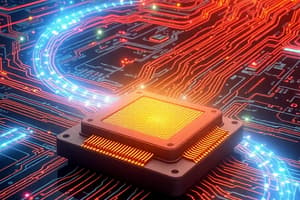Podcast
Questions and Answers
What is the first step of the fetch-execute cycle?
What is the first step of the fetch-execute cycle?
- Save
- Decode
- Fetch (correct)
- Execute
Which component is responsible for decoding the instructions during the fetch-execute cycle?
Which component is responsible for decoding the instructions during the fetch-execute cycle?
- Control unit (correct)
- ALU
- Bus
- RAM
What happens during the execute step of the fetch-execute cycle?
What happens during the execute step of the fetch-execute cycle?
- The instruction is converted into a binary form.
- The control unit sends a signal to the ALU. (correct)
- The instruction is fetched from RAM.
- Data is stored back in the RAM.
In a fetch-execute cycle, what happens to the result of an operation?
In a fetch-execute cycle, what happens to the result of an operation?
How do some computers handle the fetching of instructions and data?
How do some computers handle the fetching of instructions and data?
What is the primary function of the ALU in the fetch-execute cycle?
What is the primary function of the ALU in the fetch-execute cycle?
Which step in the fetch-execute cycle follows the decoding of an instruction?
Which step in the fetch-execute cycle follows the decoding of an instruction?
What does the control unit do during the fetch stage?
What does the control unit do during the fetch stage?
Flashcards are hidden until you start studying
Study Notes
Fetch-Execute Cycle Overview
- The CPU processes instructions at an extraordinary speed, executing millions to billions of instructions per second.
- The cycle consists of four key stages: Fetch, Decode, Execute, and Save.
Stages of the Cycle
-
Fetch:
- The control unit retrieves the instruction from RAM.
- The instruction is transferred via the bus from RAM to the control unit.
-
Decode:
- Instructions are represented as binary codes.
- The control unit interprets these codes to determine necessary actions.
-
Execute:
- The control unit signals the ALU (Arithmetic Logic Unit) to perform the operation.
- "Execute" refers to carrying out the processed instruction.
-
Save:
- If applicable, results from the ALU's computations are sent back to RAM.
- The result is stored in a designated memory location.
Variability in Data Fetching
- Some systems fetch both instructions and data in a single cycle, while others separate the fetching process into different cycles.
Example with Python Command
- Example command:
answer = 2 + 3- Fetch: Control unit fetches both the instruction to add and the data values (2, 3) from RAM.
- Decode: Instruction is decoded as an addition operation, and a signal is sent to the ALU.
- Execute: ALU performs the addition, yielding a result.
- Save: The result is stored in RAM under the label 'answer'.
Diagram Representation
- The fetch-execute cycle can be illustrated through a diagram showing the flow of operations among:
- Memory (where data and instructions are stored)
- Control Unit (manages instruction flow)
- ALU (performs arithmetic operations)
Key Takeaway
- Understanding the fetch-execute cycle is crucial for grasping how computers perform calculations and execute programs efficiently.
Studying That Suits You
Use AI to generate personalized quizzes and flashcards to suit your learning preferences.




